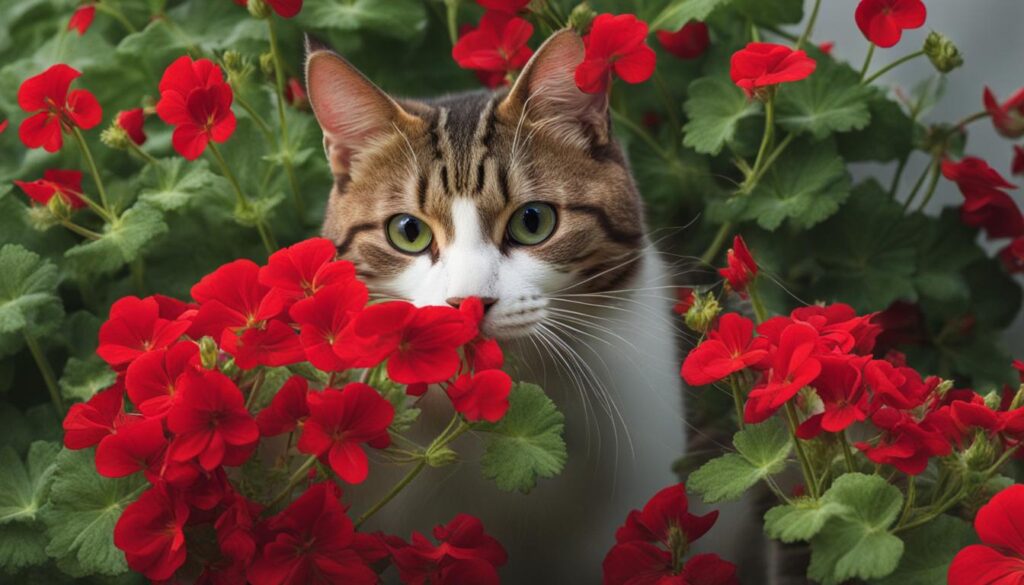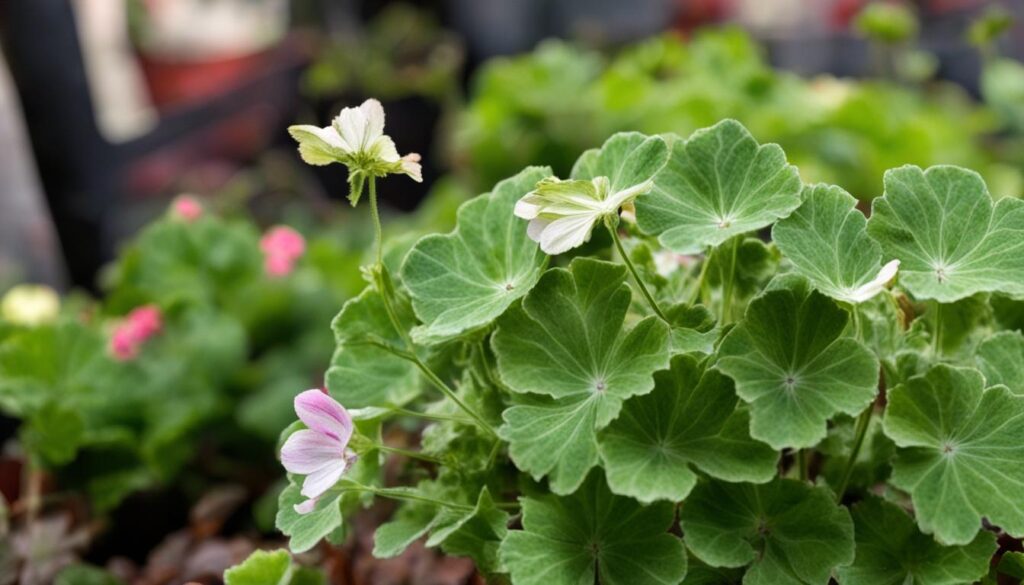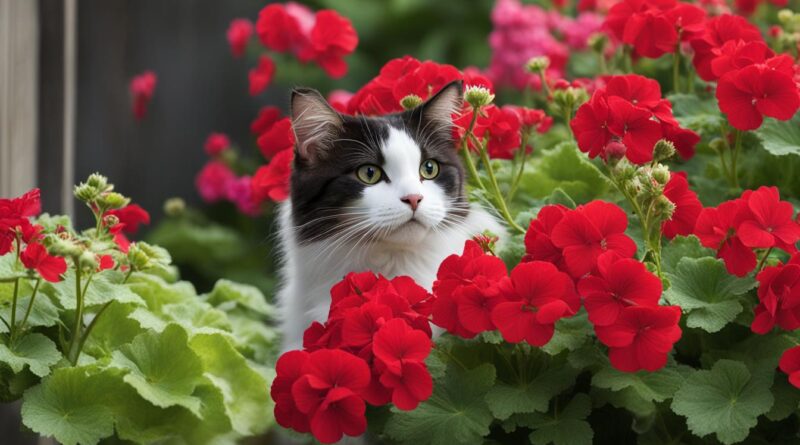Are Geraniums Poisonous to Cats? Safety Guide
Geraniums are a popular houseplant with beautiful blooms and a pleasant scent. Many cat owners wonder, “Are geraniums poisonous to cats?” It’s important to know that while geraniums can add beauty to your home, they can also pose a risk to your feline friends if ingested.
Geraniums contain toxins such as geraniol and linalool, which can have adverse effects on cats if they come into contact with them. These toxins can cause gastrointestinal upset, skin irritation, vomiting, and lack of appetite in cats. While the effects are usually mild and temporary, it’s always better to be safe than sorry when it comes to the well-being of our beloved pets.
Key Takeaways:
- Geraniums can be mildly poisonous to cats if ingested.
- They contain toxins that can cause gastrointestinal upset and skin irritation in cats.
- It’s important to keep geraniums out of reach of cats to ensure their safety.
- Consider cat-friendly plants as alternatives to geraniums.
- Always consult a veterinarian if your cat has consumed a potentially toxic plant.
What Are Geraniums?
Geraniums are a type of common houseplant known for their vibrant blooms in various colors, with red being the most common. They have a pleasant floral scent and are often used for their essential oils in beauty products. Geraniums are safe for human consumption and can be found in jams, jellies, and salad toppings.
As houseplants, geraniums can be grown indoors or outdoors in pots or window boxes. They are highly versatile and add a pop of color and beauty to any living space. The geranium’s attractive flowers and fragrance make them a popular choice for many garden enthusiasts.
“Geraniums are a delightful addition to any garden or indoor space. They provide a burst of color and a pleasant scent that can instantly uplift the atmosphere. Whether you choose to showcase them on a windowsill or use their essential oils in beauty products, geraniums are a versatile plant with various uses.”
Benefits of Geraniums
Geraniums offer several benefits as houseplants and in beauty products:
- Beautiful blooms in various colors
- Pleasant floral scent
- Essential oils used in beauty products
- Safe for human consumption
With their vibrant colors and delightful fragrance, geraniums can brighten up any space and add a touch of elegance. Their essential oils are valued for their soothing and rejuvenating properties, making them a popular choice in aromatherapy and skincare products.
Caring for Geraniums as Houseplants
Geraniums are relatively easy to care for and can thrive both indoors and outdoors. Here are some essential tips for nurturing your geranium houseplants:
- Place your geraniums in a location that receives at least 6 hours of direct sunlight.
- Water your geraniums thoroughly, allowing the soil to dry slightly between waterings.
- Use well-draining soil to prevent root rot and overwatering.
- Prune regularly to encourage bushy growth and remove wilted flowers.
- Fertilize every 4-6 weeks during the growing season to promote healthy blooms.
By following these care tips, you can ensure that your geranium houseplants thrive and continue to brighten up your living space.
| Geranium Care Tips | Geranium Benefits |
|---|---|
| Place in a sunny location | Beautiful blooms in various colors |
| Water regularly | Pleasant floral scent |
| Use well-draining soil | Essential oils used in beauty products |
| Prune regularly | Safe for human consumption |
| Fertilize during the growing season |
What Happens When a Cat Eats a Geranium?
If a cat eats a geranium, it may experience various symptoms. Some common signs of ingestion include irritation on the skin and in the mouth, vomiting, lack of appetite, and depression or lethargy. These symptoms are usually mild and temporary if the cat has only consumed a small amount of the plant. However, if a cat has ingested multiple geraniums or a large quantity, the effects can be more serious. It is important to be vigilant and watch for any abnormal behavior in cats that have consumed geraniums.
Cats that have eaten geraniums may show signs of toxicity. The toxic effects of geranium ingestion vary depending on the quantity consumed and the cat’s individual sensitivity. Some common symptoms include:
- Irritation on the skin and in the mouth
- Vomiting
- Lack of appetite
- Depression or lethargy
If you suspect that your cat has eaten a geranium and is displaying any of these symptoms, it is important to take action immediately. Contact your veterinarian for guidance and follow their recommendations.
“If a cat has ingested multiple geraniums or a large quantity, the effects can be more serious.”
Toxic Effects
The toxic effects of geranium ingestion are typically mild and temporary for cats that have consumed a small amount of the plant. However, in cases where a cat has ingested multiple geraniums or a large quantity, the effects can be more severe. The toxins in geraniums can cause gastrointestinal upset, skin irritation, and other adverse reactions in cats.
When a cat ingests geranium, the toxins can irritate the gastrointestinal system, resulting in vomiting, diarrhea, and abdominal discomfort. The toxins can also cause irritation on the skin and in the mouth, leading to inflammation, redness, and itchiness. Additionally, some cats may experience a lack of appetite, depression, or lethargy after consuming geraniums.
Signs of Ingestion
It is important for cat owners to be aware of the signs of geranium ingestion to take appropriate action promptly. If you suspect that your cat has eaten a geranium, watch for the following signs:
- Irritation on the skin and in the mouth: Look for redness, swelling, or excessive drooling.
- Vomiting: Your cat may vomit after consuming a geranium plant.
- Lack of appetite: If your cat suddenly loses interest in food, it could be a sign of geranium ingestion.
- Depression or lethargy: Cats that have eaten geraniums may appear lethargic, less active, or withdrawn.
If your cat exhibits any of these signs after eating a geranium, it is crucial to seek veterinary assistance immediately. Prompt intervention can help prevent complications and ensure your cat receives appropriate treatment.

What to Do When Your Cat Eats a Geranium
If your cat eats a geranium, it is important to take immediate action to ensure their safety. Here are the steps you should take:
-
Remove the cat from the plant: Gently remove your cat from the area where they ingested the geranium to prevent further exposure.
-
Clean the cat’s mouth: Use a damp towel to clean your cat’s mouth, both inside and out, to remove any traces of the geranium.
-
Contact veterinary assistance: Even if your cat is not showing any immediate symptoms, it is highly recommended to contact your veterinarian or the ASPCA poison control center for guidance. They can provide further instructions based on your cat’s specific situation.
-
Bring a sample of the plant: If instructed to go to the vet, try to bring a sample of the geranium plant with you. This can help the vet identify the exact plant species and provide appropriate treatment.
-
Follow veterinary instructions: If your vet advises you to stay home and monitor your cat’s condition, make sure to follow their instructions carefully. Keep a close eye on your cat and watch for any signs of distress.
Remember, it’s always better to seek professional veterinary assistance when it comes to your cat’s health. Prompt action and proper care will help ensure the well-being of your feline friend.
Which Geraniums Are Toxic to Cats?
Not all geraniums are toxic to cats. Scented geraniums, also known as Pelargonium spp., are the varieties that can be toxic when ingested by cats. These geraniums contain substances that can have adverse effects on cats’ health and well-being.
However, there is a cat-safe alternative to scented geraniums called cranesbills or Geranium spp. Cranesbills are non-toxic geraniums that are safe to have around cats. They have beautiful blooms and come in various colors, making them an attractive and safe choice for cat owners.
If you’re looking for a safe and cat-friendly option, cranesbills are a great alternative to scented geraniums. Not only do they add beauty to your home or garden, but they also ensure the well-being of your furry friends.
Harmful Effects of Toxic Geraniums on Cats
“While scented geraniums may be visually appealing and offer a pleasant fragrance, it’s important to remember that they can pose a risk to our feline companions. Ingestion of toxic geraniums can lead to gastrointestinal upset, skin irritation, and other health issues in cats.”
Toxic geraniums can cause digestive issues, such as vomiting and diarrhea, when consumed by cats. They may also experience skin irritation, which can manifest as redness, itching, or rashes. It’s essential to keep toxic geraniums away from your cats to prevent any potential harm.
Safe Alternatives to Scented Geraniums
If you’re looking for cat-safe alternatives to scented geraniums, consider the following options:
- Cranesbills (Geranium spp.): These non-toxic geraniums have a similar appearance to scented geraniums but are safe for cats. They come in various colors and can be a beautiful addition to your indoor or outdoor space.
- Catnip: Catnip is a perennial herb that many cats enjoy. It’s known for its calming effects and can be a great alternative to scented geraniums.
- Lemongrass: Not only is lemongrass safe for cats, but it also has a pleasant citrus scent. It can add a refreshing touch to your home while keeping your furry friends safe.
- Spider plants: Spider plants are non-toxic to cats and offer a unique aesthetic with their long, arching leaves. They are easy to care for and make an excellent choice for cat owners.
By choosing cat-safe alternatives, you can create a pet-friendly environment while enjoying the beauty and benefits of indoor plants.

Note: The image above provides a visual representation of toxic geraniums and can serve as a reminder to keep them out of reach of your feline friends.
Non-Toxic Plants Your Cat Will Love
If you are a cat owner looking to add some greenery to your home without compromising your cat’s safety, there are plenty of cat-friendly plants to choose from. These non-toxic plants not only beautify your space but also provide a safe environment for your furry friend to explore.
- Catnip: Catnip is a classic choice that cats absolutely adore. Its scent is irresistible to most cats and can provide them with hours of entertainment and relaxation.
- Lemongrass: Lemongrass is a fragrant herb that is safe for cats. Its citrusy aroma can help freshen up your home, and it is often used in culinary dishes as well.
- Valerian: Valerian is another plant that cats find irresistible. Its strong scent can attract cats and induce a sense of calm and relaxation.
- Spider Plant: Spider plants are not only visually appealing, but they are also non-toxic to cats. Cats are often intrigued by the dangling stems and can enjoy playing with them without any worries.
By incorporating these cat-friendly plants into your home, you can create an inviting and safe space for both you and your feline companion.
Comparison of Non-Toxic Cat-Friendly Plants
| Plant | Scent | Attractive to Cats | Additional Benefits |
|---|---|---|---|
| Catnip | Distinctive mint-like scent | Highly attractive | Can promote playfulness and provide relaxation |
| Lemongrass | Citrusy aroma | Attractive to some cats | Acts as a natural insect repellent |
| Valerian | Strong, earthy scent | Highly attractive | Can induce a sense of calmness and relaxation |
| Spider Plant | No distinct scent | Attractive to many cats | Helps in improving indoor air quality |
Remember to always research and choose cat-friendly plants to ensure the well-being of your furry friends. Providing them with safe and non-toxic plants not only enhances the aesthetic appeal of your home but also creates a harmonious environment for you and your cat to enjoy.
Conclusion
In conclusion, it is important to prioritize cat safety when it comes to toxic plants such as geraniums. While geraniums can be visually stunning and emit a pleasant scent, they can pose a risk to our feline companions if ingested. Scented geraniums, in particular, contain toxins that may lead to gastrointestinal upset and skin irritation in cats.
To ensure the well-being of your cats, it is recommended to keep scented geraniums out of your home and garden. Fortunately, there are many cat-safe alternatives available, such as cranesbills, which offer similar beauty and fragrance without posing any risk to your beloved pets.
By remaining knowledgeable about toxic plants and taking necessary precautions, you can create a safe and cat-friendly environment for your furry friends. Prioritize their safety by opting for non-toxic plants and regularly checking the toxicity of any new houseplants you introduce into your home. With these geranium precautions and cat safety measures in place, you can have peace of mind while enjoying the company of your beloved feline companions.
FAQ
Are geraniums poisonous to cats?
Yes, geraniums can be mildly poisonous to cats if ingested.
What are geraniums?
Geraniums are a type of common houseplant known for their vibrant blooms and pleasant scent.
What happens when a cat eats a geranium?
If a cat eats a geranium, it may experience symptoms such as skin and mouth irritation, vomiting, lack of appetite, and lethargy.
What should I do if my cat eats a geranium?
If your cat eats a geranium, remove it from the plant, clean its mouth with a damp towel, and contact your veterinarian or the ASPCA poison control center for guidance.
Which geraniums are toxic to cats?
Scented geraniums, also known as Pelargonium spp., are the varieties that can be toxic to cats. Non-toxic alternatives called cranesbills or Geranium spp. are safe to have around cats.
What are some non-toxic plants that cats will love?
Catnip, lemongrass, valerian, and spider plants are safe and cat-friendly alternatives to geraniums.
Why is it important to be aware of toxic plants and take precautions?
Being aware of toxic plants, such as geraniums, and choosing cat-safe alternatives is crucial to ensure the safety and well-being of your feline companions.


